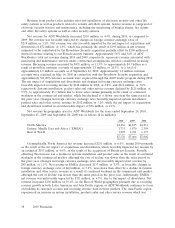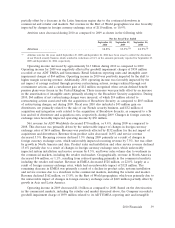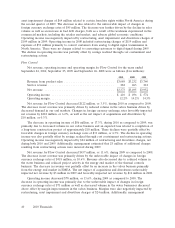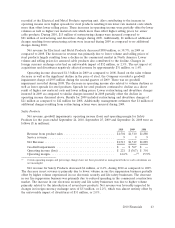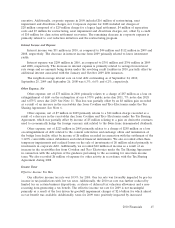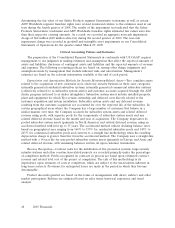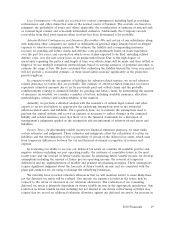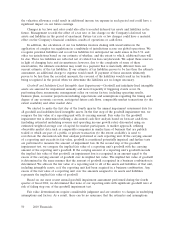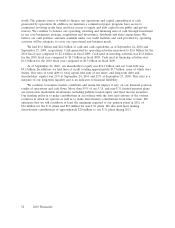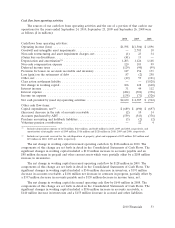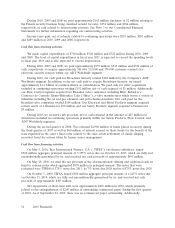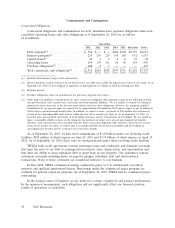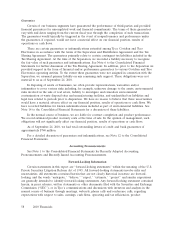ADT 2010 Annual Report Download - page 136
Download and view the complete annual report
Please find page 136 of the 2010 ADT annual report below. You can navigate through the pages in the report by either clicking on the pages listed below, or by using the keyword search tool below to find specific information within the annual report.determining the fair value of our Safety Products segment Sensormatic tradename as well as certain
ADT Worldwide segment franchise rights were revised downward relative to the estimates used in our
tests during the fourth quarter of 2008. The results of the impairment test indicated that the Safety
Products Sensormatic tradename and ADT Worldwide franchise rights estimated fair values were less
than their respective carrying amounts. As a result, we recorded an aggregate non-cash impairment
charge of $64 million ($40 million after-tax) during the second quarter of 2009. The non-cash
impairment charge was recorded in goodwill and intangible asset impairments in our Consolidated
Statements of Operations for the quarter ended March 27, 2009.
Critical Accounting Policies and Estimates
The preparation of the Consolidated Financial Statements in conformity with US GAAP requires
management to use judgment in making estimates and assumptions that affect the reported amounts of
assets and liabilities, disclosure of contingent assets and liabilities and the reported amounts of revenue
and expenses. The following accounting policies are based on, among other things, judgments and
assumptions made by management that include inherent risks and uncertainties. Management’s
estimates are based on the relevant information available at the end of each period.
Depreciation and Amortization Methods for Security Monitoring-Related Assets—Tyco considers assets
related to the acquisition of new customers in its electronic security business in three asset categories:
internally generated residential subscriber systems, internally generated commercial subscriber systems
(collectively referred to as subscriber system assets) and customer accounts acquired through the ADT
dealer program (referred to as dealer intangibles). Subscriber system assets include installed property,
plant and equipment for which Tyco retains ownership and deferred costs directly related to the
customer acquisition and system installation. Subscriber system assets and any deferred revenue
resulting from the customer acquisition are accounted for over the expected life of the subscriber. In
certain geographical areas where the Company has a large number of customers that behave in a
similar manner over time, the Company accounts for subscriber system assets and related deferred
revenue using pools, with separate pools for the components of subscriber system assets and any
related deferred revenue based on the month and year of acquisition. The Company depreciates its
pooled subscriber system assets (primarily in North America) and related deferred revenue using an
accelerated method with lives up to 15 years. The accelerated method utilizes declining balance rates
based on geographical area ranging from 160% to 195% for residential subscriber pools and 145% to
265% for commercial subscriber pools and converts to a straight line methodology when the resulting
depreciation charge is greater than that from the accelerated method. The Company uses a straight-line
method with a 14-year life for non-pooled subscriber system assets (primarily in Europe and Asia) and
related deferred revenue, with remaining balances written off upon customer termination.
Revenue Recognition—Contract sales for the installation of fire protection systems, large security
intruder systems and other construction-related projects are recorded primarily under the percentage-
of-completion method. Profits recognized on contracts in process are based upon estimated contract
revenue and related total cost of the project at completion. The risk of this methodology is its
dependence upon estimates of costs at completion, which are subject to the uncertainties inherent in
long-term contracts. Provisions for anticipated losses are made in the period in which they become
determinable.
Product discounts granted are based on the terms of arrangements with direct, indirect and other
market participants. Rebates are estimated based on sales terms, historical experience and trend
analysis.
48 2010 Financials


